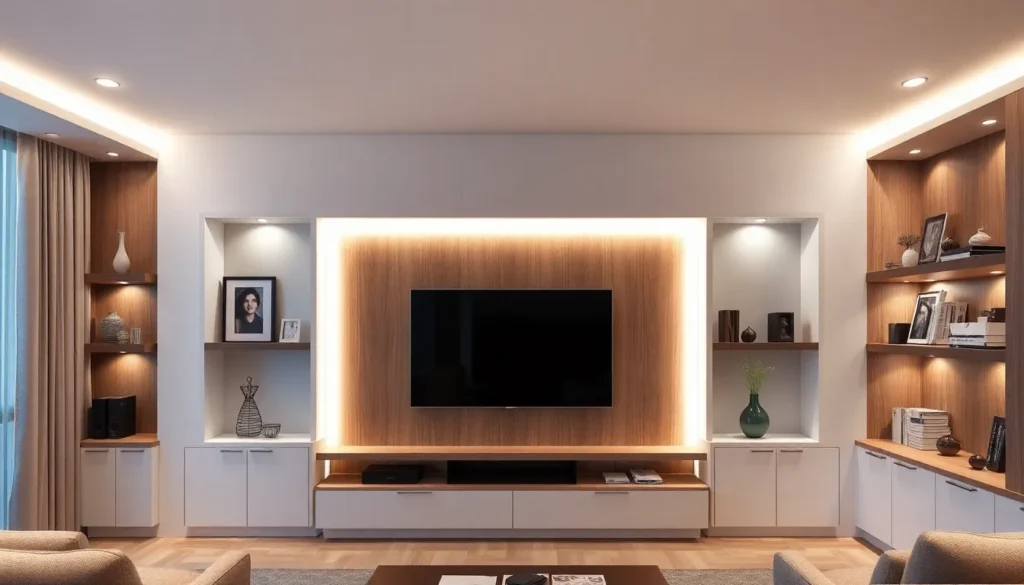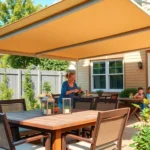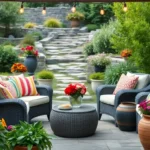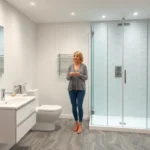We’ve all been there – staring at our living room wondering how to transform that awkward TV setup into something truly spectacular. TV unit walls have revolutionized modern living spaces by creating stunning focal points that blend entertainment with sophisticated design.
Gone are the days when we’d simply mount a television on a blank wall and call it finished. Today’s TV wall units offer endless possibilities for storage organization and aesthetic appeal. Whether you’re working with a compact apartment or a spacious family room these versatile answers can dramatically enhance your living room’s functionality and visual impact.
From sleek floating shelves to floor-to-ceiling entertainment centers we’ll explore how the right TV wall design can maximize your space while reflecting your personal style. Living room TV walls aren’t just about housing electronics anymore – they’re about creating an experience that brings families together and impresses guests from the moment they walk through your door.
Choose the Right TV Unit Size for Your Living Room Space
Selecting the perfect TV unit size ensures your living room maintains proper proportions while delivering optimal viewing comfort. We’ll guide you through the essential measurements and considerations that create a harmonious balance between your television, wall unit, and overall room design.
Measure Your Wall Dimensions Accurately
Start by measuring your wall width from corner to corner to determine the maximum size your TV unit can accommodate. We recommend using a metal measuring tape for precise measurements, as fabric tapes can stretch and provide inaccurate readings.
Document the wall height from floor to ceiling to understand vertical space limitations. Most living rooms have 8 to 10 foot ceilings, which allows for units ranging from 6 to 8 feet in height without overwhelming the space.
Mark any obstacles like electrical outlets, light switches, or architectural features that might affect unit placement. These elements often require you to adjust your TV wall unit positioning by 6 to 12 inches in either direction.
Calculate the available floor space extending from your wall into the room. Standard TV units project 12 to 18 inches from the wall, so ensure adequate walking space remains around furniture.
Consider Your TV Screen Size Requirements
Match your TV unit width to be 6 to 12 inches wider than your television screen for optimal visual balance. A 65 inch TV pairs well with a unit measuring 71 to 77 inches wide, while smaller 55 inch screens work best with 61 to 67 inch units.
Plan for future TV upgrades by choosing a unit that accommodates screens one size larger than your current model. Technology advances quickly, and this foresight prevents the need for complete unit replacement within 3 to 5 years.
Position your TV at eye level when seated to reduce neck strain during extended viewing sessions. The center of most TV screens should sit 42 to 48 inches from the floor in standard living room setups.
Consider viewing distance recommendations of 1.5 to 2.5 times your TV’s diagonal screen measurement. This means a 65 inch TV requires seating positioned 8 to 13 feet away for comfortable viewing.
Account for Ventilation and Cable Management
Ensure 4 to 6 inches of clearance around your TV’s vents to prevent overheating and extend your device’s lifespan. Modern televisions generate important heat during operation and require adequate airflow for optimal performance.
Plan cable routing paths before installing your TV wall unit to avoid drilling additional holes later. We suggest incorporating built in cable management systems or dedicated channels that keep wires organized and hidden from view.
Allocate space for media components like cable boxes, gaming consoles, and sound systems that require ventilation. Each device needs 2 to 3 inches of clearance above and behind to function properly without overheating.
Consider wireless answers for reducing cable clutter around your TV unit walls living rooms setup. Wireless HDMI transmitters, streaming devices, and Bluetooth speakers minimize the number of physical connections while maintaining full functionality.
Select the Perfect TV Wall Mount Style
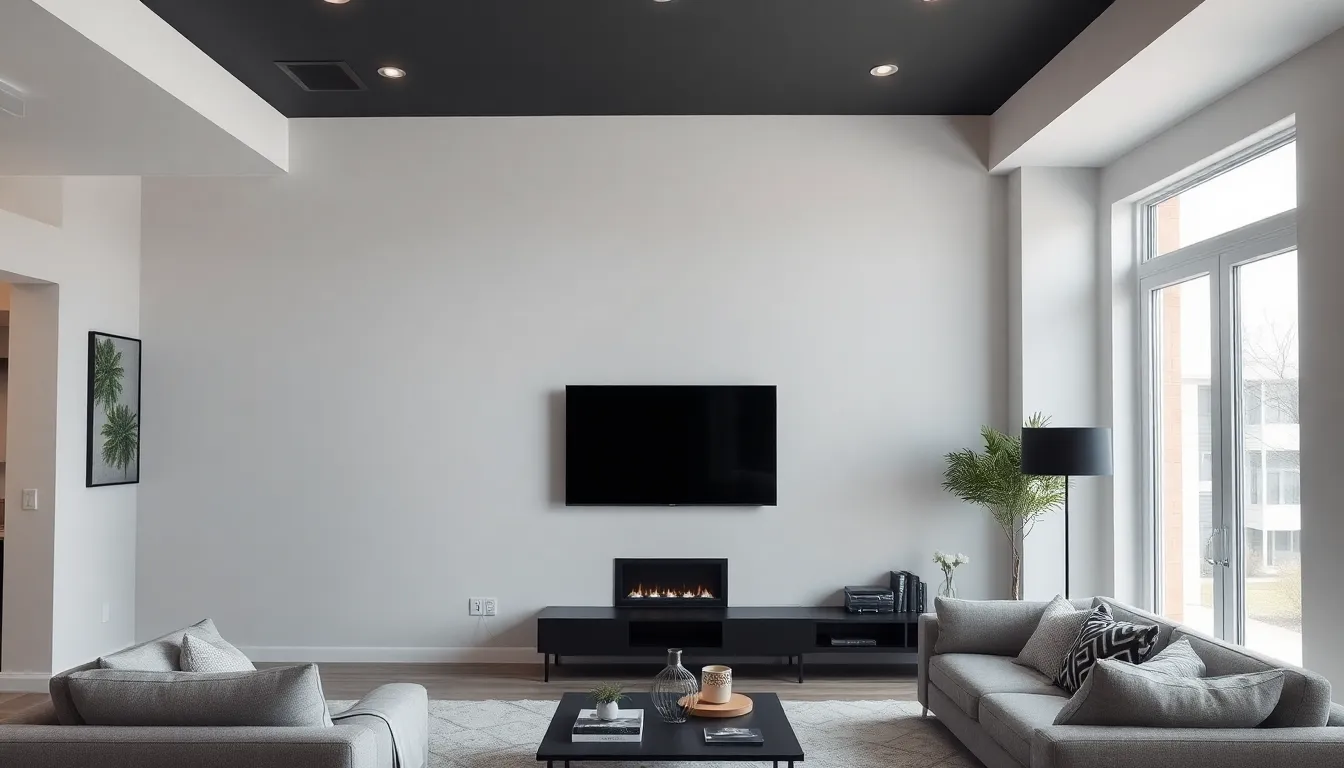
Choosing the right wall mount significantly impacts your TV unit wall’s functionality and viewing experience. We’ll explore three main mounting styles that complement different living room layouts and viewing preferences.
Explore Fixed Mount Options for Stability
Fixed mounts offer the most secure and streamlined solution for TV wall installations. These mounts position your television flat against the wall with minimal protrusion, typically extending only 1 to 2 inches from the surface. We recommend fixed mounts for living rooms where seating arrangements remain consistent and viewing angles don’t require adjustment.
Benefits of fixed mounts include:
- Maximum stability with weight capacities ranging from 30 to 200 pounds
- Lowest profile appearance that creates clean, minimalist aesthetics
- Cost effective pricing starting around $15 to $50 for most TV sizes
- Simple installation process with fewer moving parts
Fixed mounts work exceptionally well in formal living rooms or spaces where the TV serves as a permanent focal point. They’re ideal when your seating area faces directly toward the wall mount location.
Consider Tilting Mounts for Optimal Viewing Angles
Tilting mounts provide vertical adjustment capabilities while maintaining a relatively low profile against the wall. These mounts allow downward tilting of 5 to 15 degrees, making them perfect for TVs mounted above eye level or over fireplaces.
Key advantages of tilting mounts:
- Reduced glare from windows or ceiling lights
- Better viewing angles when TV placement is higher than 42 inches from the floor
- Price range of $25 to $75 for most residential applications
- Maintains sleek appearance while offering angle flexibility
We suggest tilting mounts for living rooms with high ceilings or when incorporating the TV into existing built in entertainment centers. They’re particularly useful when natural light creates viewing challenges during different times of day.
Evaluate Full-Motion Mounts for Flexibility
Full motion mounts deliver maximum versatility with swiveling, tilting, and extending capabilities. These articulating mounts can rotate left or right up to 90 degrees and extend 12 to 20 inches from the wall, accommodating multiple viewing zones within your living room.
Full motion mount features include:
- Complete directional control for any seating arrangement
- Extension capabilities that allow access to TV connections
- Weight support from 30 to 100 pounds depending on arm construction
- Investment range of $50 to $200 for quality options
Full motion mounts excel in open concept living spaces where viewing occurs from kitchen islands, dining areas, or multiple seating groups. They’re essential when your TV unit wall serves dual purposes or when furniture arrangements change frequently. Consider the extended position clearance requirements when selecting this mount style for your entertainment setup.
Design Your TV Unit Layout for Maximum Impact
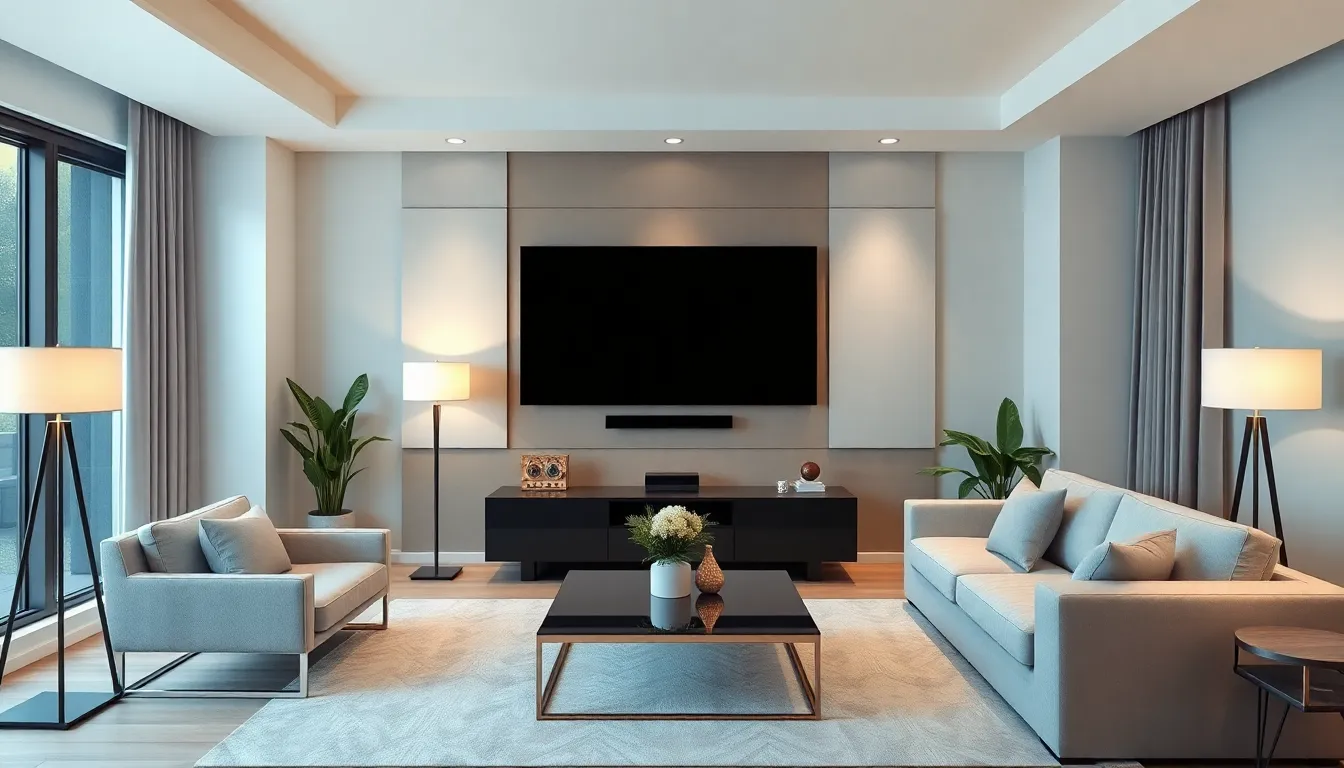
Creating an impactful TV unit layout transforms your living room into a cohesive entertainment space that draws the eye and serves your daily needs. Strategic planning ensures every element works together harmoniously.
Create a Focal Point Around Your Television
Center your TV unit as the room’s primary visual anchor by positioning it on the longest wall where it naturally commands attention. We recommend building outward from the television with complementary elements like floating shelves, cabinets, or decorative panels that frame the screen without overwhelming it.
Install ambient lighting behind or around your TV unit to create depth and visual interest during evening viewing sessions. LED strip lights, wall sconces, or recessed lighting options enhance the focal point while reducing eye strain. Consider warm white temperatures between 2700K and 3000K for a cozy atmosphere.
Layer decorative elements at varying heights around your television to create visual movement and prevent the space from feeling flat. Picture frames, plants, books, or sculptural objects arranged on shelves or stands add personality while maintaining the TV’s central importance. Keep decorative items to a minimum on the same level as your screen to avoid distraction during viewing.
Balance Visual Weight with Surrounding Furniture
Position heavier furniture pieces strategically to distribute visual weight evenly across your living room layout. We place substantial items like large sofas, armchairs, or storage ottomans at angles or distances that complement rather than compete with your TV unit wall. Dark colored or oversized furniture should balance the TV wall’s prominence without creating visual tension.
Match your TV unit’s scale to surrounding seating arrangements by ensuring the entertainment center doesn’t dwarf nearby furniture or appear lost among larger pieces. A 75 inch TV unit pairs well with sectional sofas, while 50 inch units complement standard three seat couches and accent chairs.
Incorporate storage answers that serve dual purposes by selecting coffee tables, side tables, or media consoles that provide functionality while maintaining visual harmony. These pieces should echo your TV unit’s material, color, or design style to create a cohesive look throughout the space.
Incorporate Symmetrical Design Elements
Flank your TV unit with matching elements to create a sense of order and sophistication in your living room design. We recommend placing identical floor lamps, tall plants, or narrow bookcases on either side of the entertainment center to establish visual balance. This approach works especially well with larger TV units spanning 60 inches or more.
Arrange decorative objects in pairs or odd numbered groupings on shelves and surfaces surrounding your television area. Three matching vases, two identical picture frames, or a set of five books create visual rhythm while maintaining the symmetrical foundation. Vary heights slightly within each grouping to add interest without breaking the balanced aesthetic.
Repeat colors and textures throughout the space to reinforce the symmetrical design theme beyond just physical placement. We suggest echoing your TV unit’s finish in picture frames, lamp bases, or decorative bowls positioned around the room. This repetition creates visual threads that tie the entire living space together while supporting the central TV wall focal point.
Optimize Storage Solutions in Your TV Unit
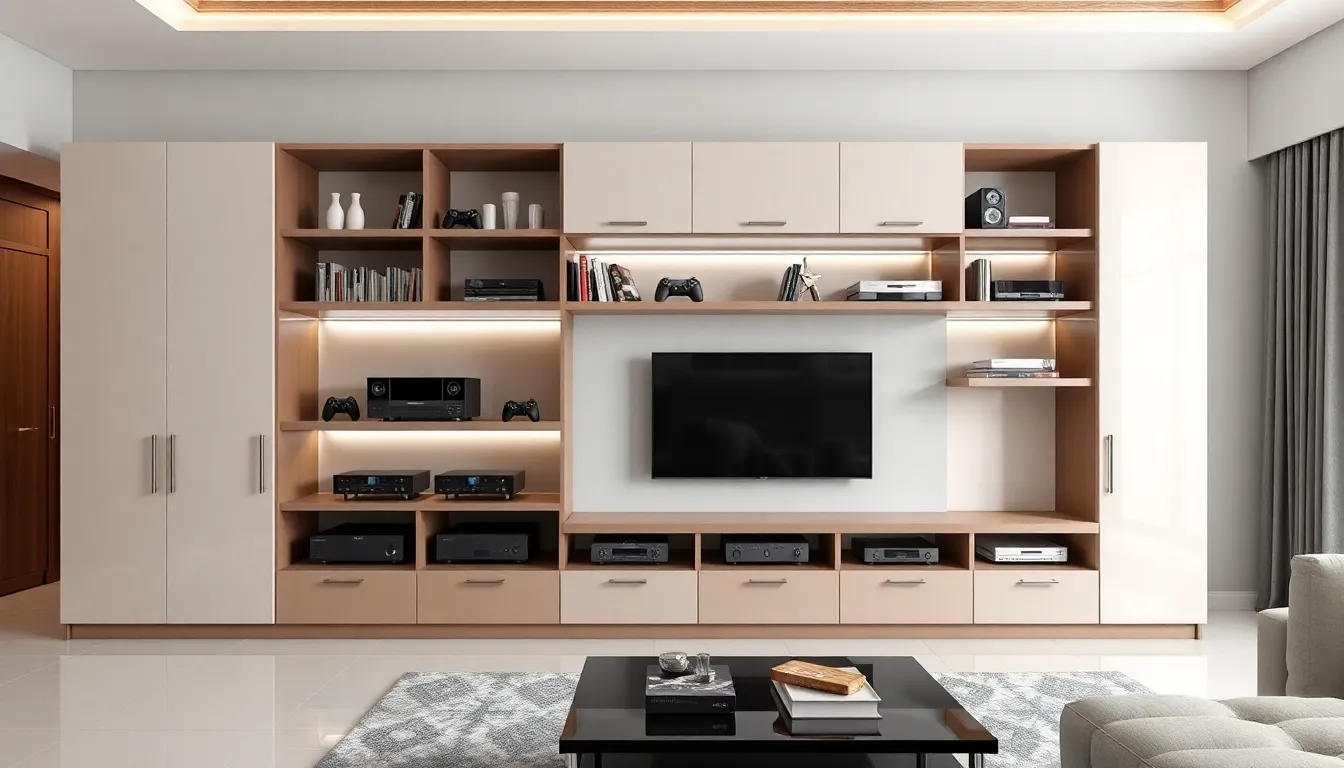
Smart storage transforms your TV unit wall from a simple display into an organized entertainment hub. We’ll explore three essential storage strategies that maximize functionality while maintaining your living room’s clean aesthetic.
Add Built-in Shelving for Media Components
Built-in shelving creates designated spaces for your essential media equipment while keeping everything easily accessible. Open shelves accommodate cable boxes, streaming devices, sound bars, and gaming systems with proper ventilation for heat dissipation.
Position shelving at varying heights to fit different component sizes and depths. Standard cable boxes measure 12 inches wide by 8 inches deep, while streaming devices like Apple TV require just 4 inches of space. Design wider shelves for larger components such as receivers or gaming consoles.
Install adjustable shelving systems to adapt your storage as technology changes. Floating shelves maintain the wall’s modern appearance while providing adequate support for equipment weighing up to 50 pounds per shelf.
Wire management becomes effortless with built-in cable channels running behind shelving units. Route power cords and HDMI cables through these hidden pathways to maintain your TV unit’s sleek profile.
Include Closed Cabinets for Clutter Control
Closed cabinets hide visual clutter while protecting valuable electronics from dust and accidental damage. We recommend incorporating at least one closed storage area for every three open shelving sections to balance accessibility with organization.
Cabinet doors keep remotes, batteries, instruction manuals, and spare cables completely out of sight. Choose soft-close hinges to prevent slamming and ensure quiet operation during movie nights or late-evening viewing.
Size cabinets based on your exact storage needs and living room scale. Lower cabinets work well for storing large items like board games, photo albums, or seasonal decorations that relate to your entertainment space.
Ventilation remains crucial even in closed storage areas. Install small vents or leave slight gaps at cabinet backs to prevent overheating of stored electronic components.
Design Compartments for Gaming Consoles and Accessories
Gaming console compartments require exact dimensions and features to accommodate modern systems safely. PlayStation 5 measures 15.4 inches tall, while Xbox Series X stands 11.8 inches high, so plan vertical clearance accordingly.
Create pull-out drawers for gaming accessories like controllers, headsets, and game cartridges. These sliding compartments make items easily accessible while keeping them organized and protected from damage.
Incorporate charging stations within gaming compartments to eliminate cord clutter on coffee tables or side surfaces. Built-in USB ports and wireless charging pads keep controllers ready for use without creating additional cable management challenges.
Consider adjustable dividers within gaming storage areas to accommodate different console generations or multiple gaming systems. This flexibility ensures your TV unit storage remains functional as gaming technology evolves.
Enhance Your TV Wall with Decorative Elements
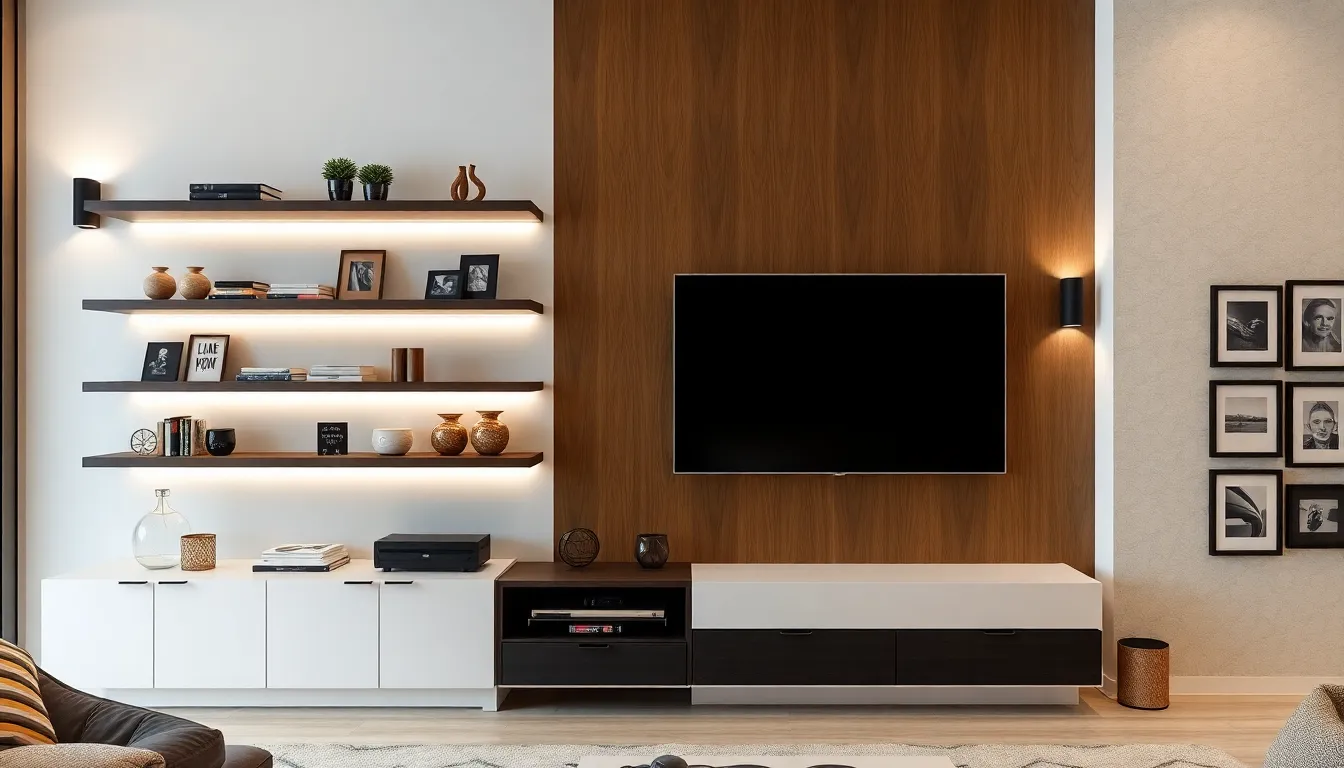
Transform your TV unit wall from a simple entertainment setup into a captivating focal point with thoughtful decorative elements. Strategic additions create visual interest while maintaining the clean aesthetic you’ve worked to achieve.
Frame Your Television with Accent Lighting
LED strip lights positioned behind your TV create a dramatic backlight effect that reduces eye strain during viewing. We recommend installing color-changing LED strips that allow you to adjust the ambiance from warm white for movie nights to cool blue for gaming sessions.
Wall sconces flanking your television add architectural interest while providing ambient lighting for the entire room. Position these fixtures 24 to 36 inches away from your TV’s edges to avoid glare on the screen.
Recessed lighting built into floating shelves or TV unit compartments highlights decorative objects while drawing attention to your entertainment wall. Install dimmable options so you can control the intensity based on different activities throughout the day.
Under cabinet lighting illuminates lower shelving areas and creates depth in your TV wall design. These fixtures work especially well when you have multiple tiers of storage or display areas around your television.
Add Floating Shelves for Display Items
Asymmetrical shelf arrangements create visual interest around your TV unit while providing space for decorative objects and media storage. We suggest installing shelves at varying heights and lengths to break up the rigid lines of rectangular televisions.
Corner floating shelves maximize unused wall space near your TV unit and offer perfect spots for small plants, books, or decorative containers. These shelves work particularly well in smaller living rooms where every inch of storage matters.
Gallery style shelving transforms blank wall areas above or beside your TV into curated display zones for artwork, family photos, and collectibles. Keep displays balanced by grouping items in odd numbers and varying heights for the most appealing arrangement.
Integrated media shelves built into your TV wall unit design hold gaming consoles, streaming devices, and sound equipment while keeping cables organized and hidden. Choose shelves with built in cable management systems to maintain that clean, professional appearance.
Incorporate Wall Art and Personal Touches
Gallery walls positioned adjacent to your TV unit create visual balance and prevent the television from dominating the entire wall space. We recommend using frames in consistent colors or finishes to tie the arrangement together with your entertainment setup.
Statement mirrors reflect light throughout your living room while making the space feel larger and more open. Position mirrors strategically to avoid reflecting your TV screen back at viewers during use.
Textural wall panels made from wood, fabric, or stone add dimension behind or around your TV unit without competing for attention. These panels work especially well in modern living rooms where you want to create warmth without busy patterns.
Personal collections displayed on floating shelves or in built in niches showcase your interests while making the TV wall feel more lived in and welcoming. Rotate seasonal items or travel mementos to keep your entertainment area feeling fresh and current.
Choose Appropriate Materials for Your TV Unit

Selecting the right materials transforms your TV wall from a simple entertainment setup into a sophisticated design statement. We’ll explore three distinct material categories that offer unique benefits for creating stunning living room centerpieces.
Select Durable Wood Options for Longevity
Solid hardwood stands as our top recommendation for TV units that need to support heavy equipment while maintaining their beauty for decades. Oak, maple, and walnut varieties resist warping and scratches better than softwood alternatives, making them ideal for high-traffic living spaces.
Engineered wood products like plywood and MDF offer stability at lower costs while still providing wood’s natural warmth. These materials accept stains and paints beautifully, allowing us to match existing furniture finishes or create bold accent colors that complement our room’s design scheme.
Reclaimed wood elements bring character and sustainability to modern TV walls, with each piece telling its own story through unique grain patterns and weathered textures. Barn wood, railway ties, and vintage flooring create rustic charm that contrasts beautifully with sleek electronics and contemporary accessories.
Consider Modern Metal and Glass Combinations
Steel framework construction delivers industrial elegance while supporting substantial weight loads that accommodate large TVs and multiple components. Powder-coated finishes resist fingerprints and maintain their appearance through daily use, requiring minimal maintenance compared to traditional wood surfaces.
Tempered glass shelving creates an open, airy feel that makes living rooms appear larger while showcasing decorative items and media collections. These transparent surfaces reflect light throughout the space, improving ambient lighting effects and reducing visual clutter around entertainment areas.
Mixed material designs combine metal supports with glass panels or wood accents to achieve balanced aesthetics that work with various interior styles. Chrome and brass details add luxury touches, while matte black finishes provide modern sophistication that complements contemporary electronics and furniture pieces.
Explore Budget-Friendly Composite Materials
Laminate surfaces mimic expensive wood and stone finishes at a fraction of the cost, offering scratch resistance and easy cleaning for busy households. Modern laminate technology creates realistic textures and patterns that fool the eye while standing up to daily wear from children and pets.
Particleboard and MDF cores provide stable foundations for TV units when properly constructed with quality veneers or paint finishes. These engineered materials resist moisture better than solid wood and accept hardware securely, ensuring our wall mounts and bracket systems remain firmly attached.
Vinyl wrapped panels deliver consistent colors and finishes across large TV wall installations without the natural variations found in wood products. These materials clean easily with standard household products and resist fading from sunlight exposure, maintaining their appearance in bright living rooms.
Integrate Cable Management Systems Effectively
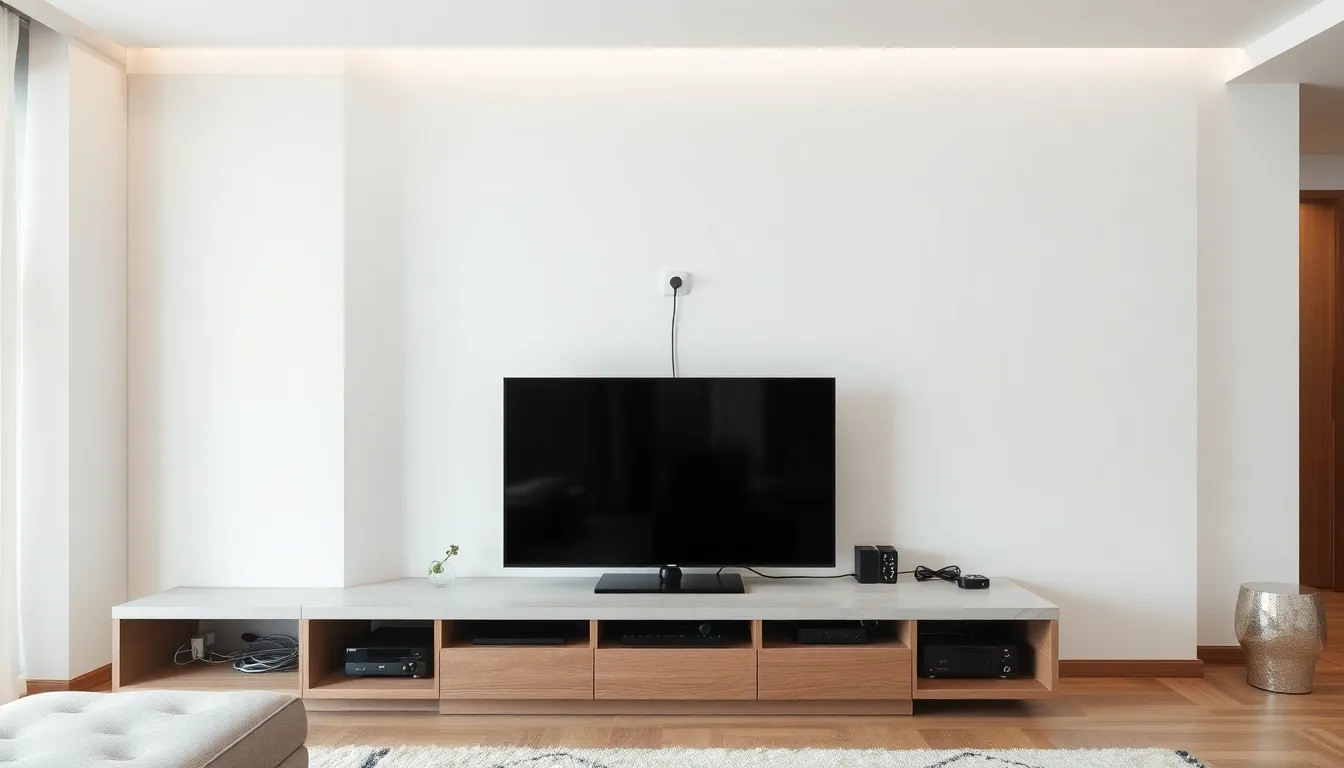
Clean cable management transforms your TV unit wall from cluttered chaos into a sleek entertainment centerpiece. We’ll explore three proven approaches that eliminate visible wires while maintaining easy access to your components.
Hide Wires with In-Wall Cable Routing
In-wall cable routing creates the cleanest possible look for your TV unit setup. Installing dedicated cable conduits during construction or renovation allows us to run power cables, HDMI connections, and ethernet wires directly through wall cavities. Most professional installations include a recessed outlet box behind the TV location connected to a lower access point near your media components.
Building codes require exact cable types for in-wall installation. We must use CL2 or CL3 rated cables that meet fire safety standards when routing wires through wall spaces. Standard HDMI cables often lack proper ratings, so investing in certified in-wall versions prevents code violations and safety hazards.
Retrofit answers work well in existing homes without major renovations. Cable management kits with paintable covers create channels along wall surfaces, mimicking the in-wall appearance while remaining accessible for future changes. These systems typically cost $50-150 and include mounting hardware, cable guides, and decorative covers that blend seamlessly with your wall color.
Use Cable Organizers and Cord Covers
Cable organizers keep visible wires neat and professional looking behind your TV unit. Spiral cable wrap bundles multiple cords into single organized runs, while adhesive cable clips secure individual wires along cabinet edges or wall surfaces. We recommend using matching colors that blend with your TV unit materials for the most seamless appearance.
Cord covers provide instant answers for surface-mounted cable runs. Paintable plastic channels attach directly to walls using adhesive backing or small screws, creating clean lines from your TV down to media components. Split-back designs allow easy cable insertion without removing the entire cover, making future upgrades simple and convenient.
Under-cabinet cable management trays maximize organization within TV unit storage areas. These sliding mesh trays mount inside cabinets to hold power strips, cable boxes, and gaming consoles while keeping all connecting wires contained and accessible. Most trays include ventilation holes and adjustable mounting brackets to fit various cabinet dimensions.
Plan Power Outlet Placement Strategically
Strategic outlet placement eliminates extension cord usage throughout your TV unit wall setup. Installing outlets directly behind the TV location and within each storage compartment ensures every component has dedicated power access without visible cords. We recommend adding 20% more outlets than currently needed to accommodate future equipment additions.
GFCI outlets provide enhanced safety for entertainment centers in certain room locations. Basement TV walls and areas near moisture sources benefit from ground fault circuit interrupter protection, though standard outlets work fine for typical living room installations. Consulting a qualified electrician ensures proper circuit capacity and code compliance for your exact setup.
USB outlets integrated into TV unit designs support modern device charging needs. Built-in USB ports eliminate bulky charging adapters while keeping phones, tablets, and controllers powered during use. Many smart outlets now include wireless charging pads that mount directly into cabinet surfaces, creating convenient charging zones without additional cables or adapters.
Create a Cohesive Color Scheme for Your TV Wall
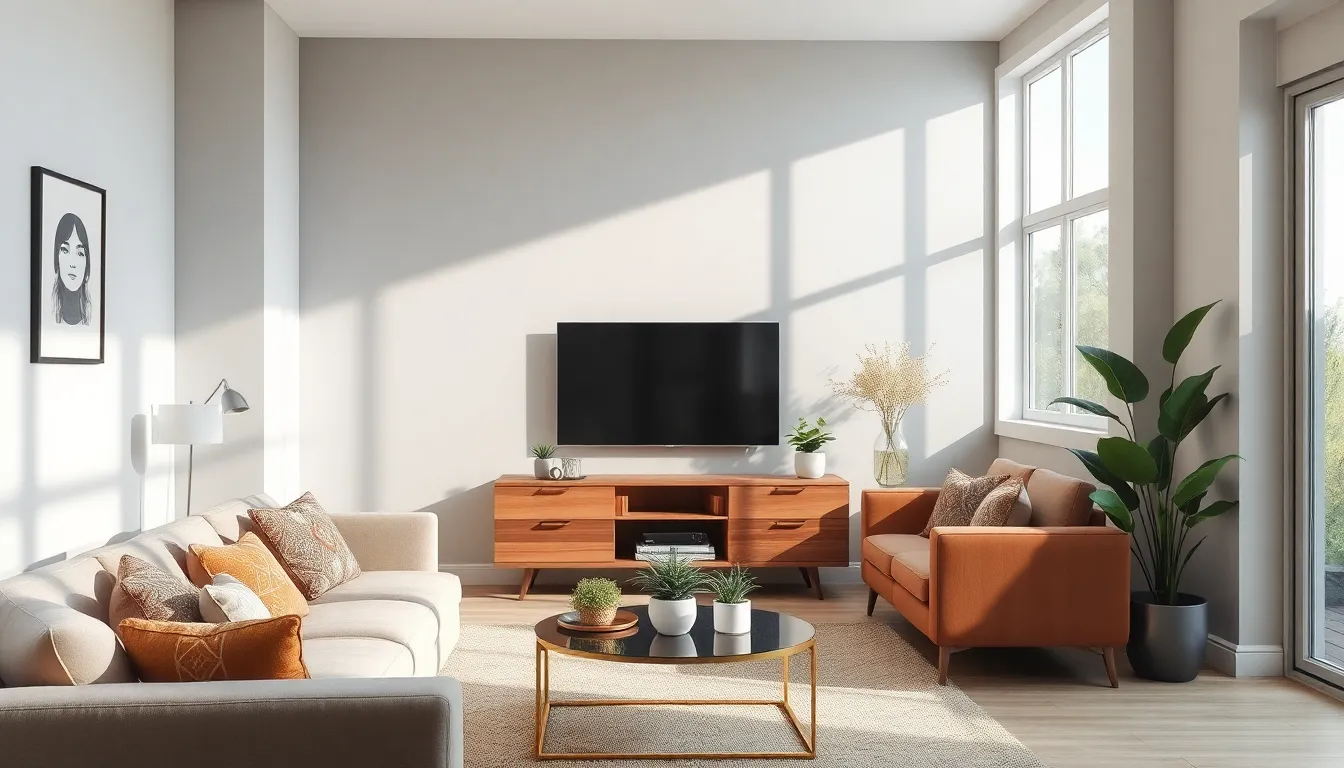
Your TV wall’s color palette sets the foundation for your entire entertainment space design. We’ll explore three strategic approaches to achieve visual harmony while expressing your personal style.
Match Your TV Unit to Existing Décor
Coordinating your TV unit with current room elements creates seamless integration throughout your living space. Examine your existing furniture finishes, from coffee tables to side chairs, and select TV unit materials that complement these established tones.
Warm wood tones work beautifully when your space already features oak dining tables or walnut accent pieces. We recommend sampling wood stains on small test pieces to ensure perfect color matching before committing to your full TV unit installation.
Paint colors should echo your wall palette or trim work for maximum cohesion. Cream colored TV units pair naturally with beige walls, while charcoal units complement gray paint schemes effectively. Consider your upholstery colors too, as fabric patterns and textures provide excellent color inspiration for TV wall design decisions.
Use Contrasting Colors for Visual Interest
Strategic color contrast transforms your TV wall into a ever-changing focal point that commands attention. Dark TV units against light walls create dramatic depth, making your entertainment area feel more spacious and sophisticated.
White or light gray units pop against navy blue accent walls, establishing clear visual boundaries between your TV zone and surrounding areas. Bold contrasts like black units on cream walls deliver modern elegance while maintaining timeless appeal.
Metallic accents add sophisticated contrast without overwhelming your color scheme. Brushed brass hardware on dark wood units creates luxurious contrast, while chrome details on white units maintain contemporary freshness. Temperature contrast works effectively too, pairing cool grays with warm wood tones for balanced visual interest.
Consider Neutral Tones for Timeless Appeal
Neutral color palettes provide enduring sophistication that adapts to changing décor trends over time. Beige, gray, and cream TV units offer versatile foundations that accommodate seasonal decorating updates without requiring major renovations.
Greige combinations blend gray and beige undertones, creating warm neutrals that feel both contemporary and inviting. These sophisticated hues work with virtually any accent color, from vibrant throw pillows to colorful artwork displays.
Monochromatic neutral schemes layer different shades of the same color family for subtle depth. Light gray TV units paired with medium gray walls and charcoal accessories create graduated tonal interest without visual competition. Natural wood tones in honey or driftwood finishes provide organic neutral options that bring warmth to minimalist color schemes.
Plan for Future Technology Upgrades
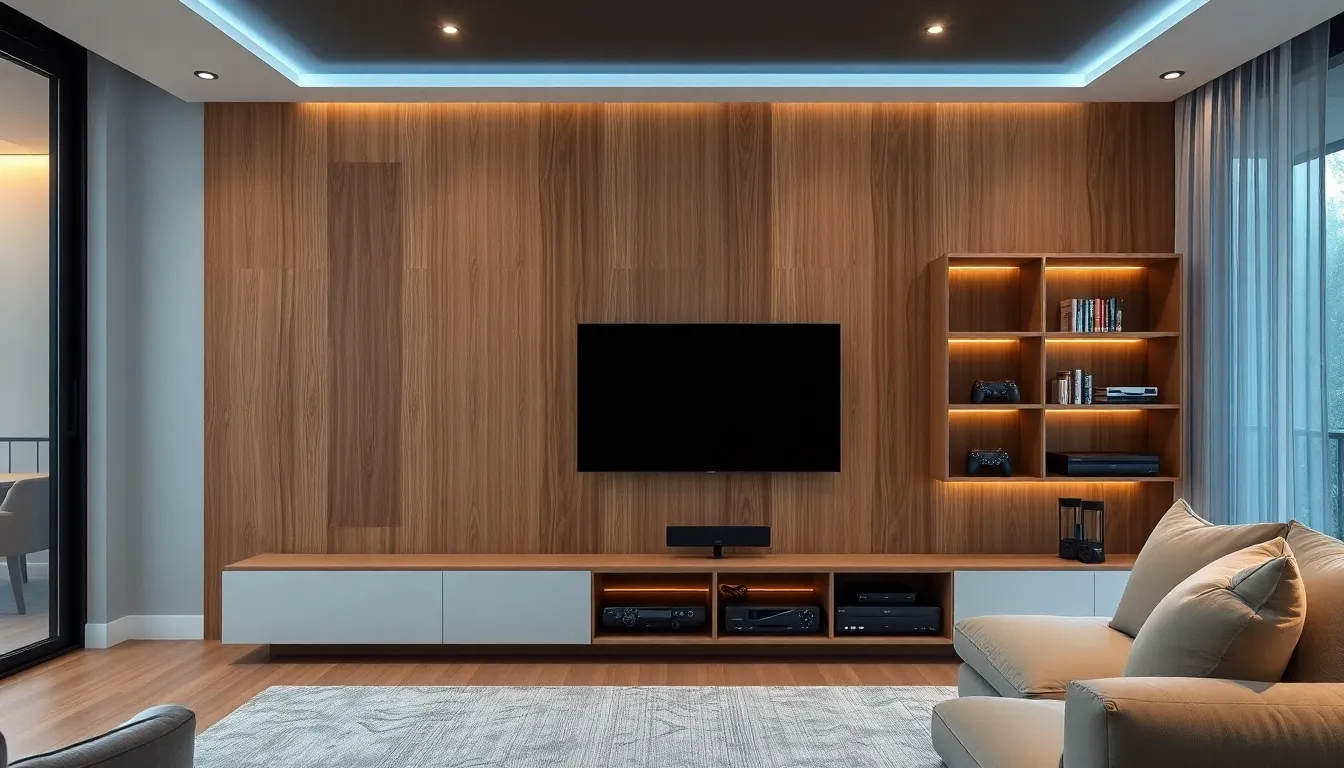
Future-proofing your TV unit wall ensures you’ll adapt to evolving technology without costly redesigns. We’ll explore strategies that accommodate tomorrow’s entertainment innovations while maximizing today’s functionality.
Design Flexible Mounting Systems
Adjustable mounting tracks offer the ultimate flexibility for future TV changes and upgrades. We recommend installing horizontal or vertical rail systems that allow you to reposition your television without creating new wall holes. These track systems accommodate different TV sizes and weights while maintaining clean cable routing through integrated channels.
Modular bracket designs provide versatility when upgrading to larger screens or different mounting angles. We suggest choosing systems with interchangeable components that work with various TV brands and sizes. Many modular mounts include adapters for VESA patterns ranging from 100x100mm to 800x600mm, ensuring compatibility with future purchases.
Universal mounting plates eliminate compatibility concerns when switching TV brands or models. We install backing plates with standard VESA hole patterns that work with multiple bracket types. This approach saves time during upgrades since the wall preparation remains intact while only the bracket hardware changes.
Allow Space for Evolving Entertainment Needs
Gaming console compartments should accommodate current systems while planning for next-generation devices. We design storage spaces 20% larger than current gaming systems to handle future consoles, which historically increase in size with each generation. Our recommended dimensions include 18-inch wide by 14-inch deep compartments with adequate ventilation for thermal management.
Streaming device storage requires flexible answers since these components continue shrinking while increasing in number. We create dedicated shelves with built-in power strips and cable management for multiple streaming boxes, gaming devices, and smart home hubs. These shelves should measure at least 12 inches wide with 4-inch height clearance for stacking devices.
Future display technology preparation involves planning for larger screens and new mounting requirements. We recommend designing wall supports that can handle TV weights up to 150 pounds, even if your current screen weighs significantly less. This preparation includes reinforcing wall studs and installing blocking for potential future mounting points.
Consider Smart Home Integration Options
Voice control compatibility transforms TV walls into smart entertainment hubs that respond to verbal commands. We position smart speakers within 8-10 feet of the main seating area for optimal voice recognition while hiding wiring within the wall system. Popular voice assistants like Alexa, Google Assistant, and Siri integrate seamlessly with modern TV units through dedicated mounting brackets.
Automated lighting systems enhance viewing experiences while supporting smart home ecosystems. We install LED strips with programmable controllers that sync with TV content, adjust for ambient light conditions, and respond to voice commands. These systems typically consume 15-30 watts and can be controlled through smartphone apps or smart home platforms.
Climate control integration allows your TV wall to communicate with HVAC systems for optimal comfort during extended viewing sessions. We recommend installing smart sensors that detect occupancy and adjust room temperature automatically. These sensors connect to central home automation systems and can reduce energy costs by 10-15% through intelligent climate management.
Conclusion
We’ve covered the essential elements that transform ordinary TV walls into stunning entertainment hubs that perfectly balance style and functionality. From selecting the right mount and optimizing storage answers to implementing smart cable management and creating cohesive color schemes your TV unit wall can become the centerpiece your living room deserves.
The key lies in thoughtful planning that considers both current needs and future technology upgrades. By incorporating flexible mounting systems accommodating smart home integration and choosing durable materials you’re investing in a setup that’ll serve you well for years to come.
Remember that the best TV unit walls seamlessly blend with your existing décor while providing the storage and organization your entertainment needs demand. With these strategies you’re ready to create a space that impresses guests and enhances your daily viewing experience.
Frequently Asked Questions
What makes a modern TV unit wall different from traditional TV setups?
Modern TV unit walls combine entertainment functionality with sophisticated design, transforming awkward setups into stunning focal points. Unlike traditional setups that simply mount a television, contemporary TV walls offer integrated storage solutions, aesthetic appeal, and cohesive design elements that enhance both functionality and personal style in any size living room.
How do I choose the right size TV unit for my living room?
Measure your wall dimensions accurately and consider obstacles like windows or doors. Match your TV unit width to your screen size, plan for future upgrades, and ensure the TV is positioned at eye level for optimal viewing comfort. Allow adequate space for ventilation and cable management while maintaining proper proportions with your room size.
What are the main types of TV wall mounts available?
There are three main mounting styles: fixed mounts for stability and minimalist appearance, tilting mounts for vertical adjustment and optimal viewing angles, and full-motion mounts for maximum flexibility in viewing positions. Each type offers different benefits and price ranges depending on your living room layout and viewing preferences.
How can I design my TV unit layout for maximum visual impact?
Center your TV unit on the longest wall and incorporate complementary elements like shelves and ambient lighting. Balance visual weight with surrounding furniture, match the TV unit’s scale to nearby seating arrangements, and use symmetrical design elements with matching items on either side for sophistication and order.
What storage solutions work best in TV units?
Optimize functionality with three key strategies: built-in shelving with proper ventilation for media components, closed cabinets for clutter control and electronics protection, and specialized compartments for gaming consoles with features like pull-out drawers and built-in charging stations to maintain organization and accessibility.
How can I enhance my TV wall with decorative elements?
Use accent lighting like LED strips and wall sconces to frame the television. Add floating shelves with asymmetrical arrangements, incorporate gallery-style displays, and include wall art, statement mirrors, and textural panels. Showcase personal collections to make the space feel more inviting while maintaining a clean, organized look.
What materials work best for TV units?
Choose from durable wood options like solid hardwood, engineered wood, or reclaimed wood for longevity and aesthetic appeal. Modern metal and glass combinations offer industrial elegance and open feels. Budget-friendly composite materials like laminate and vinyl-wrapped panels provide practical, cost-effective solutions for various design needs.
How do I manage cables effectively in my TV unit wall?
Use three approaches: in-wall cable routing for seamless looks, retrofit solutions for existing homes, and cable organizers with cord covers. Place power outlets strategically to avoid extension cords, use GFCI outlets in moisture-prone areas, and integrate USB outlets for modern charging needs to maintain a sleek, functional setup.
What color schemes work best for TV walls?
Create visual harmony with three strategic approaches: match your TV unit to existing décor for seamless integration, use contrasting colors for visual interest, or choose neutral tones for timeless appeal. Coordinate colors with existing furniture and wall palettes, and sample materials before finalizing decisions for cohesive design.
How can I future-proof my TV unit wall?
Design flexible mounting systems with adjustable tracks and modular brackets for easy repositioning. Create storage spaces larger than current models with built-in power strips. Integrate smart home features like voice-controlled speakers, automated lighting systems, and climate control connections to ensure your setup remains functional as technology advances.

